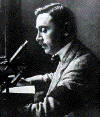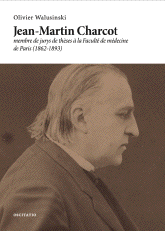-
The
physiological experiments of
- Constantin
von Economo
- on
the central pathways
- of
mastication and deglutition
- Petousi VG, Proios H, Triarhou LC.
- Rev Neurol (Paris)
- 2019;175(9):506-518
-
- Baron
Constantin Von Economo
-
- Encephalitis
lethargica
- Encéphalite
léthrgique
|
-
The concept of a
central pattern generator
-
- The first study of Constantin von Economo on the
mammalian brain was published in 1902. Experiments were
carried out in rabbits at the Physiological Institute
headed by Siegmund von Exner-Ewarten in Vienna to
investigate the central pathways of chewing and
swallowing. After placing cortical lesions, Economo
applied cortical and subcortical electrical stimulation
to obtain masticatory movements, and tracked degenerated
fibers by means of the Marchi method. He traced fibers
through the internal capsule, ventral nucleus of the
thalamus, subthalamic nucleus, substantia nigra and its
connections with the motor nucleus of the trigeminal
nerve, and nucleus solitarius.
-
- He suggested that the substantia nigra is responsible
for coordinating alimentation movements, with the
involvement of cranial nerves V, VII, IX and X as well.
We discuss these findings in a historical and a modern
perspective, including the concept of a central pattern
generator in the pontine reticular formation and its
interaction with the nucleus solitarius. Today we
understand that mastication is a voluntary action
controlled by motor cortical areas, by motoneurons of the
trigeminal, and by a neural pattern generator in the
pons. On the other hand, deglutition comprises 'reflex
swallowing' triggered by sensory fibers of cranial nerves
V, IX and X, and 'voluntary swallowing' which may be
controlled by both cortical fields and subcortical areas,
such as the internal capsule, the hypothalamus and the
mesencephalic reticular formation.
-
- In all, the neural mechanisms controlling mastication
and deglutition emanate from centers in the brainstem.
Moreover, these activities may be modulated both by
conscious processes and by feedback from peripheral
nerves. It might be added that yawning
shares activation of the same motor nuclei of cranial
nerves V, VII, IX, X, XI.
-
 -
- Le concept de
générateur central
-
- La première étude de Constantin von
Economo sur le cerveau des mammifères a
été publiée en 1902. Des
expériences ont été menées
chez le lapin à l'Institut de physiologie
dirigé par Siegmund von Exner-Ewarten à
Vienne afin d'étudier les voies principales de la
mastication et de la déglutition.
-
- Après avoir pratiqué des lésions
corticales, Economo a appliqué une stimulation
électrique corticale et sous-corticale pour
obtenir des mouvements masticatoires et a suivi les
fibres dégénérées au moyen de
la méthode de Marchi. Il a localisé les
fibres traversant la capsule interne, le noyau ventral du
thalamus, le noyau sous-thalamique, la substance noire et
ses connexions avec le noyau moteur du nerf trijumeau et
le noyau solitarius.
-
- Il a suggéré que la substantia nigra
était responsable de la coordination des
mouvements de mastication-déglutition, avec
l'implication des nerfs crâniens V, VII, IX et X
également.
-
- Les auteurs discutent ces résultats dans une
perspective historique et moderne, y compris le concept
d'un générateur central dans la formation
réticulaire pontine et son interaction avec le
noyau solitaire.
-
- Nous comprenons aujourd'hui que la mastication est
une action volontaire contrôlée par les
aires corticales motrices, par les motoneurones du
trijumeau et par un générateur situé
dans le pont. Par contre, la déglutition comprend
la «déglutition réflexe»
déclenchée par les fibres sensorielles des
nerfs crâniens V, IX et X, et la
«déglutition volontaire» qui peut
être contrôlée à la fois par
les aires corticales et les zones sous-corticales, telles
que la capsule interne, l'hypothalamus et la formation
réticulaire mésencéphalique.
-
- En résumé, les mécanismes
neuronaux contrôlant la mastication et la
déglutition émanent de centres
situés dans le tronc cérébral. De
plus, ces activités peuvent être
modulées par des processus conscients et par des
rétroactions d'origine
périphériques. On
peut ajuter que le bâillement partage l'activation
des noyaux moteurs des mêmes nerfs craniens V,VII,
IX, X, XI.
|
-
A
Book Review
- Jean-Gaël Barabara
- Journal
of the History
- of
the Neurosciences
- 2020
|
-
Georges Gilles de la
Tourette,
beyond the
Eponym
- Olivier Walusinski
-
- Oxford University Press 2019
-
- The vast historiography of the French
Salpêtrière neurological school of Paris
includes complete biographical works of its main
principal representatives. Missing, however, has been
substantial work on Georges Gilles de la Tourette
(1857&endash;1904), who has received some attention
principally due to his eponymous syndrome. The interest
of neurologists in his life and work faded after
Grégory Duncan published a thesis devoted to him
in 1955. Olivier Walusinski, one of the best specialists
in the history of French neurology, collaborated with
Duncan in 2010 on Gilles de la Tourette, and this
collaboration, along with help from Jean-Philippe Neau,
led him to the discovery of new personal archival
material in Loudun, the city of origin of Gilles de la
Tourette's family. Relying on these documents, Walusinki
has written an extensive, original, and well-informed
biography on the life and the works of Gilles de la
Tourette.....
- to be
continued
|




